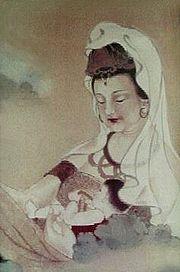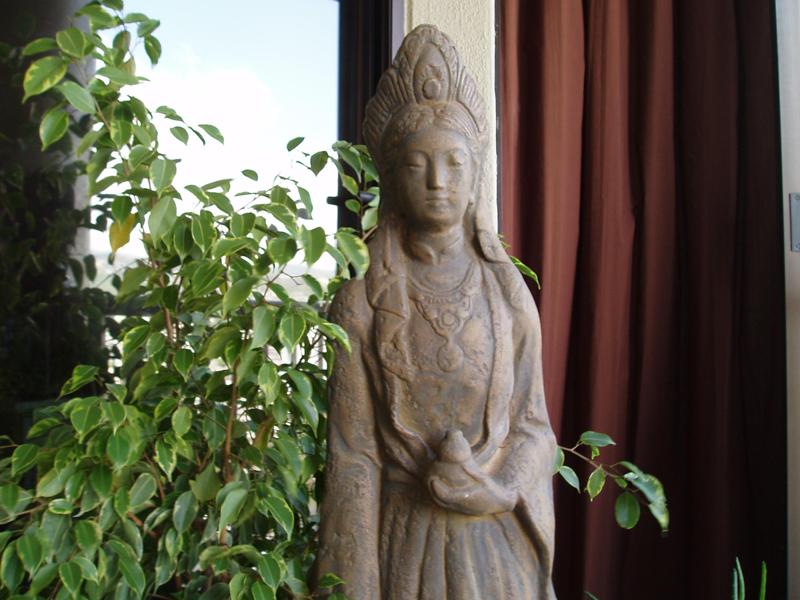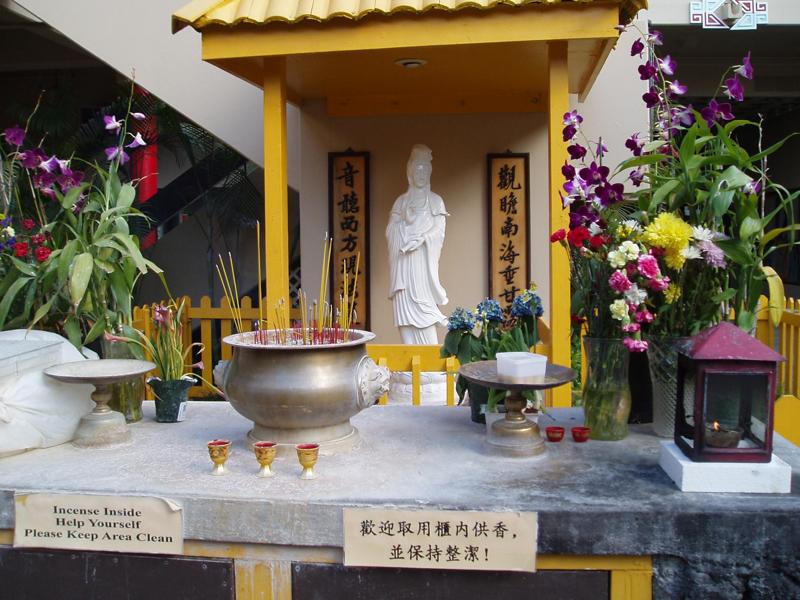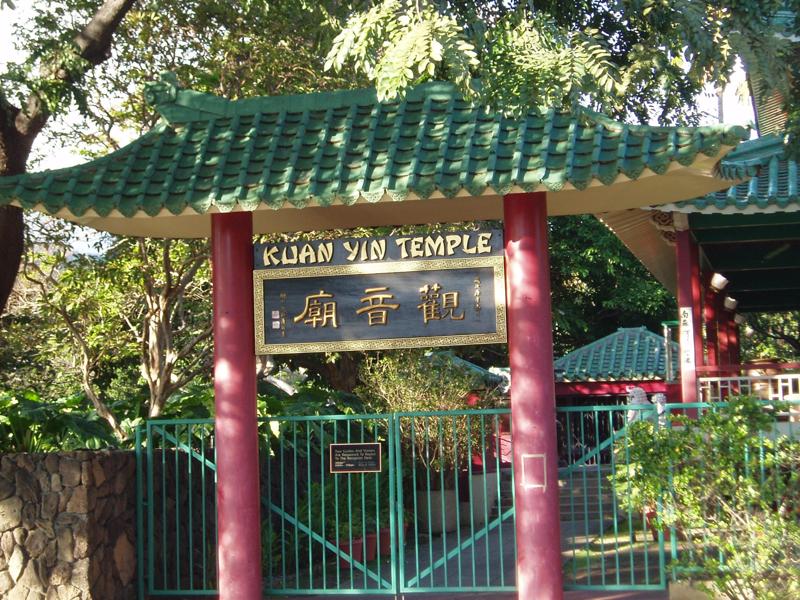The Order of the White Moon Gallery Presents
THE CHINESE GODDESS OF COMPASSION
Kuan Yin
by
ETAIN© All original material in this site is under copyright protection and is the intellectual property of the author.
Known in the far east; Japan, Korea, Tibet, Viet Nam and China by many names and with a variety of spellings; Kuan-Yin (pronounced Koo-wan’yin) is also Kwan-Yin, Quan-Yin, Kwai-Yin and Kwannon. In China she is the personification of compassion itself, the “compassionate One” (1) and “the most powerful being in the entire Chinese Pantheon.” (7)
As the Chinese Buddhist bodhisattva “Kuan-Yin embodies the Divine Feminine” (1) and is known as the “Great Mother of China”. (8) She is the goddess of fertility, of healing and of magic. She is a mother figure, a friend, a guide and a protector for women. She is what ever you need her to be. For it is her sacred task to “hear the cries of the world” and to answer them with love, mercy and compassion.
It was during the first century C.E. that Buddhism was introduced into mainland China. Along with the Buddha came the teachings of the bodhisattva Avalokitesvara. He was a male figure, although by all appearances an androgynous being, and he was called Kuan Shin Yin by the Chinese.
Within the Lotus Sutra, now considered a sacred text, is the telling of the coming of Avalokitesvara (translated, “the lord who regards the cries of the world”) and of his choosing to delay his own final enlightenment in order to stay on earth and help others. However, the Chinese viewed the nurturing qualities being attributed to the man Kuan Shin Yin as more appropriately feminine.
So over time, by the seventh century, they had changed the Avalokitesvara from a male entity into the Goddess Kuan-Yin. It is the Goddess Kuan-Yin that has endured and who is loved by millions around the world today.
In Eastern mythology there are many stories written about the Goddess Kuan-Yin and how she came to be bodhisattva. My favorite is the one about Miao Shan a beautiful young woman and the youngest of three daughters. Because of her “unearthly virtue” (7) and her absolute devotion to Buddha she refused her fathers plans for an arranged marriage and entered a Buddhist nunnery.
Her father in a fit of rage burned the nunnery to the ground causing her death. Miao Shan was then carried by a rainbow to the heavens where, because of her innocent death, she was granted transmutation into the Divine World to become a female bodhisattva. Her soul was then returned to earth in human form as the bodhisattva Kuan-Yin where “she spent her days relieving the suffering of those in distress.” (9)
She was believed to have lived on the island of Pu Tuo Shan (translated; beautiful white flower), located off the coast of China, in her “sacred cave home of Ch’ao-Yin.” (5) Here, it’s written that, she aided women during child birth, she healed the sick and wounded and she saved the lives of sailors and fishermen. Even today, “On Pu Tuo Shan Kuan-Yin is called the Goddess of the Southern Sea and patroness of fishermen.” (8)
There are also stories from the Himalayas where travelers lost in storms are led to the safety of nearby caves by a young girl believed to be Kuan-Yin. However, the healing stories are the ones most often told and they are continuing to provide supportive evidence of her great powers and unwavering compassion.
Photo Copyright 2006(c)Etain
Due to Kuan-Yins great popularity statues of her are being found out side the traditional Buddhist temples. In China, Japan, Vietnam and Korea they are seen beside rivers, on hillsides and along the sea shore.
Here in the west she is found on home altars, on desktops and bedside tables and in sacred gardens. Many different images are being created today of Kuan-Yin in various postures and using a variety of materials.
Statues can easily be found at affordable prices; in wood, jade, marble, ceramic, porcelain, rock crystal etc.... She is sometimes depicted sitting on a lotus flower, a fish, an elephant, a dolphin, on the back of a lion-like beast or with dragons at her feet. She may be nursing a baby or holding a child. The boy Shan Ts’ai and the girl Lung Nu who some time assist Kuan-Yin may be seen at her feet on either side.
Photo Copyright 2006(c)Etain
The image of Kuan-Yin most often seen in my community is that of a tall, slender young Chinese woman, standing or floating on a lotus flower, barefooted and bejeweled dressed in long flowing white robes. Her head is veiled and she carries upon her face a soft gentle expression of love and compassion. In one hand she holds a small vase which contains Amitra “the dew of compassion” that is said to have the power to extend life, to cure and purify both body and mind when she pours or sprinkles it over human kind. (9)
Many honor the Goddess Kuan-Yin through the deeply rooted yet simple ritual of chanting. One that is often used, here in it’s shortened form, “Kuan Yin P’u-Sa”, is basically a greeting to the goddess. Another chant that I personally like is the Avalokitesvara mantra; “Om Mani Padme Hum”, which translated means “Hail to the Jewel in the Lotus”.
Just speaking her name is believed to draw her near and, in a chant-like repetition, is especially effective. I have added this simple chant while walking, creating a walking meditation. In the words of Patricia Monaghan, “worship need not be complicated to be effective. Kuan-Yin’s worship shows us how simple it can be to follow the Goddess path.” (11)
In my personal meditations with the Kuan-Yin she speaks with me as an ancient mother goddess. In the course of my research for this project I was thrilled to realize a sense of validation for my belief of such an ancient connection. Z. Budapest quotes Merlin Stone from her book, “Ancient Mirrors of Womanhood” that “the worship of Kuan-Yin is older than Buddhism by far. She was the ancient Nu Kwa. Both words Nu and Yin mean woman.” Nu Kwa was the creator goddess of ancient China, and a mythic remnant of “China’s Matriarchal Age”. (5) (7) (8)
Recent archaeological discoveries in China revealed evidence that early Nomadic peoples had worshiped the Earth Mother and were decedents of women who are believed to have been amazons. (9)
The ancient Goddess Pi-Hsia Yuan-Chin was to Chinese Taoists a major divinity and is believed to be one and the same as the Buddhist Kuan-Yin. Just as Goddess survived within the Christian beliefs as Holy Mary Mother of God; so she has endured within Buddhism as the bodhisattva Kuan-Yin. Perhaps it is in these “myths” that the truth lies.
Kuan-Yin’s special dates and celebrations:
Patricia Monaghan writes in her books, “The Goddess Companion” and “The Goddess Path” that traditionally there were several festival celebrations for the Goddess Kuan-Yin that took place on the nineteenth day of the second, sixth and ninth lunar months.
The first of these dates, February 19th was her birthday celebration and July 12th marks the date that she took her sacred vow to return to earth as bodhisattva. October 14th is another date for celebrating of Miao Shan’s transmutation into the all compassionate Kuan-Yin. April 5th is also a festival date where Kuan-Yin is celebrated in Japan and China. (2)
Sacred Symbols and Emblems of Kuan-Yin:




